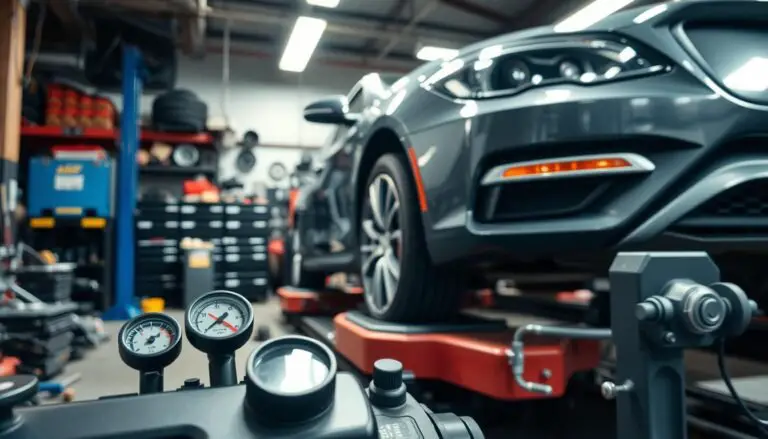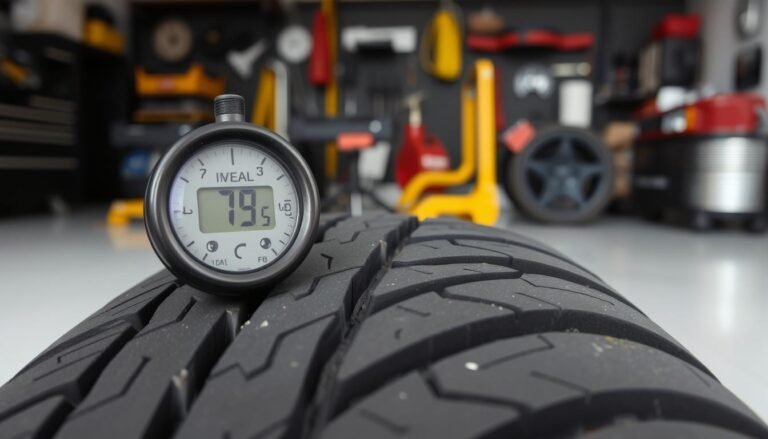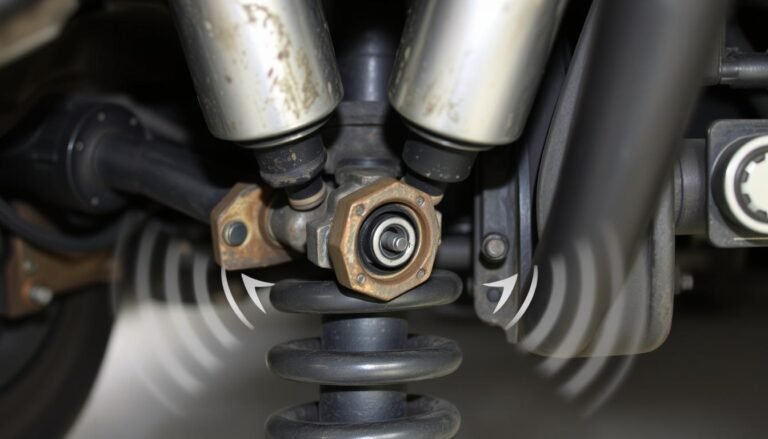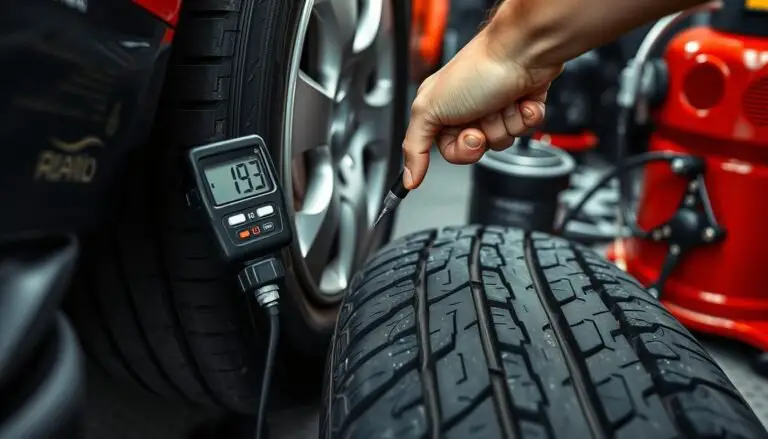What are the Signs of a Bad Wheel Bearing?
Wheel bearings are key in your car’s suspension system. They let the wheels spin smoothly. If a wheel bearing fails, it can cause many problems. These issues can affect how your car handles, performs, and stays safe.
It’s important to spot the early signs of a bad wheel bearing. This helps prevent more damage and keeps your car running well.
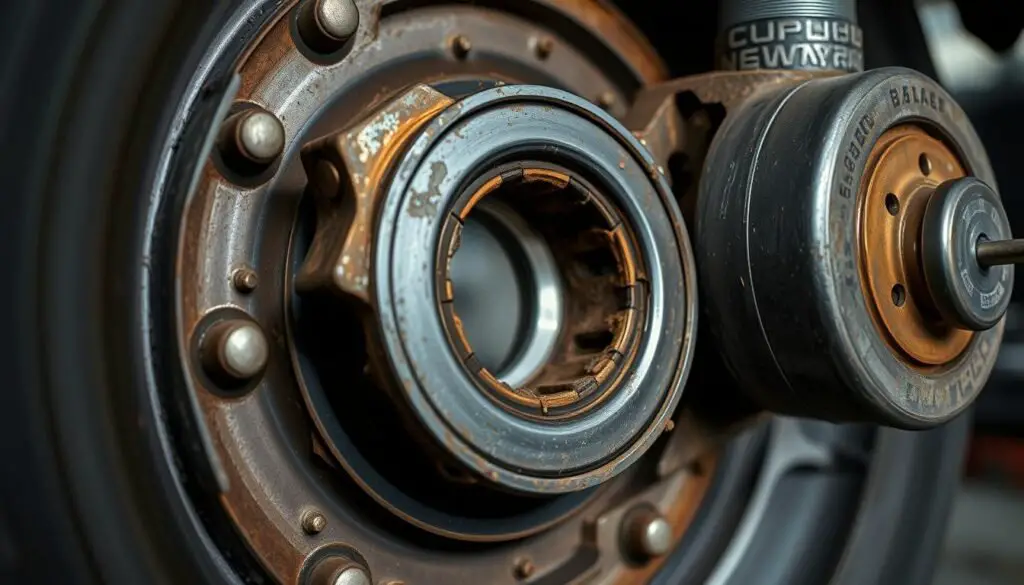
Key Takeaways
- Unusual noises like grinding, rumbling, or whirring can indicate a problem with the wheel bearing.
- Vibration or wobbling in the steering wheel may be a sign of a worn or damaged wheel bearing.
- Uneven tire wear is often a symptom of a faulty wheel bearing that needs to be addressed.
- Steering wheel vibration and a vehicle pulling to one side can also signify a wheel bearing issue.
- Regular inspections and prompt repairs are crucial to maintain the safety and performance of your vehicle.
What is a Wheel Bearing?
A wheel bearing is key in a car’s suspension system. It lets the wheel spin smoothly. It’s inside the wheel hub, making the wheel turn easily. Wheel bearings are important for a car’s performance and safety.
Purpose and Location
The main job of a wheel bearing is to cut down on friction. This lets the wheel turn with little effort. It’s in the wheel hub, connecting to the suspension system. This spot helps the bearing handle the car’s weight and forces while driving.
Types of Wheel Bearings
There are various wheel bearings, each with its own design. The main types are:
- Ball bearings: These have spherical parts that make the wheel turn smoothly.
- Roller bearings: These use cylindrical parts, offering more strength and stability.
The type of wheel bearing used depends on the car’s use, load needs, and suspension design.
“A well-functioning wheel bearing is essential for ensuring a smooth and safe ride, as it helps maintain proper wheel alignment and reduces the risk of premature tire wear.”
Common Signs of a Bad Wheel Bearing
It’s important to know the signs of a bad wheel bearing. This helps you catch the problem early and avoid bigger issues. Look out for unusual noises, vibrations, handling problems, and uneven tire wear.
A grinding sound or rumbling noise from a wheel is a common sign. This noise gets louder when you drive faster. You might feel it through the steering wheel or the floor.
- Grinding or rumbling noise that increases in volume as speed increases
- Vibration or wobbling sensation while driving
- Uneven or premature tire wear on the affected side
- Steering wheel vibration or wandering
- Vehicle pulling to one side while driving
These signs can change in how loud or often they happen. But they all mean you might have a wheel bearing problem. If you ignore these signs, you could face more damage, higher repair costs, and even danger on the road.
| Sign | Description |
|---|---|
| Grinding or Rumbling Noise | A grinding or rumbling sound that gets louder as the vehicle’s speed increases, often felt through the steering wheel or the floor. |
| Vibration or Wobbling | A noticeable vibration or wobbling sensation while driving, particularly at higher speeds. |
| Uneven Tire Wear | Premature or uneven tire wear on the affected side of the vehicle. |
| Steering Wheel Vibration | Vibration or shaking felt in the steering wheel, which may increase in intensity at higher speeds. |
| Vehicle Pulling | The vehicle pulling or drifting to one side while driving, even on a straight and level road. |
Knowing these signs can help you fix a bad wheel bearing before it gets worse. Regular checks and quick fixes can keep your car safe and running well.
Grinding or Rumbling Noise
A grinding or rumbling noise from your wheel is a clear sign of trouble. This sound happens when the bearing parts wear out. It leads to more friction and metal rubbing against metal.
Causes and Characteristics
The sound of your wheel bearing noise can tell you a lot. A grinding sound that gets louder as you go faster means the bearing is really worn out. On the other hand, a rumbling noise that stays the same at any speed might mean the bearing is failing earlier.
Don’t ignore wheel bearing noise. It can get worse and cause big problems like wheel separation or damage to the drivetrain. Fixing it early can save you money and keep your car safe.
“Paying attention to the unique sounds coming from your wheels can help you identify potential bearing issues before they become a major problem.”
Vibration or Wobbling
A bad wheel bearing often causes a vibration or wobbling feeling while driving. This happens because the bearing can’t keep the wheel properly aligned and stable. As a result, the wheel rotates unevenly and unstably.
The vibration can make driving uncomfortable and may even cause more damage if ignored. It’s important for drivers to notice any vibration while driving and look out for signs of a bad wheel bearing.
- Increased vibration at higher speeds
- Unstable, uneven wheel rotation
- Feeling of the wheel “wobbling” or shaking
- Potential for additional wear and tear on other suspension components
If you notice these symptoms, get your car checked by a mechanic right away. They can find and fix the wheel bearing problem before it gets worse.
Fixing a bad wheel bearing quickly makes driving safer and more comfortable. Knowing the signs of a bad wheel bearing helps keep your car’s suspension system in good shape. This way, you avoid safety risks on the road.
Uneven Tire Wear
Uneven tire wear often points to a bad wheel bearing. As the bearing fails, it can make the wheel misaligned. This leads to specific wear patterns on the tires.
Pattern and Causes
Cupping or scalloping are common signs of a bad wheel bearing. These patterns show as concave depressions or irregular wear on the tire’s tread. This happens because the wheel bearing is loose, causing the wheel to wobble.
One-sided tire wear is another sign of a failing wheel bearing. As the bearing fails, the wheel can become misaligned. This causes the tire to wear down faster on one side than the other.
| Tire Wear Pattern | Possible Cause |
|---|---|
| Cupping or Scalloping | Excessive play or looseness in the wheel bearing |
| One-sided Tire Wear | Misaligned wheel due to a failing wheel bearing |
By noticing the patterns of uneven tire wear, car owners can spot wheel bearing problems early. This helps avoid more serious issues like uneven tire wear and safety hazards.
What are the signs of a bad wheel bearing?
It’s important to spot the early signs of a bad wheel bearing to keep your car safe and running well. These bearings help your wheels move smoothly. If they fail, it can cost a lot to fix.
A grinding or rumbling noise from the wheel is a common sign. This sound gets louder when you’re going fast or turning. As the bearing wears out, the metal parts rub against each other, making a bad noise.
You might feel a vibration or wobbling while driving. This happens when the bearing gets weak, causing the wheel to shake. If ignored, it could make the wheel stop working or fall off.
Also, if your tires wear down unevenly, it might mean your wheel bearing is bad. When the bearing fails, the wheel tilts, wearing the tire on one side more than the other. This uneven wear is a clear warning sign.
Feeling a steering wheel vibration or noticing your car pulling to one side while driving? These are signs of a bad wheel bearing too. The bearing can’t support the wheel properly, making the car unstable.
Spotting these signs early can prevent bigger problems and keep your car safe. If you think your wheel bearings are failing, get a professional to check them right away.
| Sign | Description |
|---|---|
| Grinding or Rumbling Noise | A grinding or rumbling sound coming from the affected wheel, often more noticeable at higher speeds or when turning. |
| Vibration or Wobbling | A vibration or wobbling sensation in the affected wheel, indicating a loss of stability and increased lateral movement. |
| Uneven Tire Wear | Asymmetrical wear pattern on the tire, caused by the wheel bearing’s inability to properly support the wheel. |
| Steering Wheel Vibration | A vibration in the steering wheel, resulting from the bearing’s failure to properly support the wheel. |
| Vehicle Pulling | The vehicle pulling to one side while driving, caused by the bearing’s inability to maintain proper wheel alignment. |

“Early detection and repair of a problematic wheel bearing can save you from more costly repairs down the road and ensure the safety of your vehicle.”
Steering Wheel Vibration
A common sign of a bad wheel bearing is a vibration in the steering wheel. This happens when the bearing can’t keep the wheel properly aligned. This leads to uneven rotation. The vibration’s strength and how often it happens can tell you how bad the problem is.
Intensity and Frequency
The vibration’s strength and how often it happens can show how bad the wheel bearing is. Severe problems cause strong, constant vibrations. Smaller issues might cause a light, occasional vibration.
For example, a strong, steady vibration means the bearing is badly worn and needs fixing fast. But a light, occasional vibration might just need a small fix or a new bearing.
| Vibration Intensity | Vibration Frequency | Possible Bearing Condition |
|---|---|---|
| High | Persistent | Severely worn or damaged bearing |
| Mild | Intermittent | Less severe bearing issue |
Watching the steering wheel vibration helps you spot and fix steering wheel vibration. It’s a key sign of a bad wheel bearing.
Vehicle Pulling to One Side
If your vehicle starts pulling to one side while driving, it might mean a wheel bearing problem. This issue happens when the bearing can’t keep the wheel aligned right. This leads to uneven weight and poor handling. It’s crucial to fix this quickly for safe driving.
One clear sign of a bad wheel bearing is when your vehicle pulls to one side. This can occur for a few reasons:
- The wheel bearing wears out, causing the wheel to misalign and pull in that direction.
- The bearing seizes, making the wheel bind and pull towards that side.
- The bearing gets loose, letting the wheel move too much and cause wandering or pulling.
It’s vital to tackle this issue fast. A bad wheel bearing can mess with your vehicle’s handling and stability. It also raises the risk of a dangerous situation on the road.

If you see your vehicle pulling to one side, get a mechanic to check the wheel bearings. Don’t ignore it. Ignoring this could lead to more damage and even a wheel failure. This could be very dangerous.
Diagnosis and Inspection
If you think your vehicle’s wheel bearings might be a problem, it’s important to get a pro to check them. A skilled mechanic can do a detailed wheel bearing diagnosis and wheel bearing inspection. They use special tools to find the problem and decide if it needs fixing or replacing.
Professional Evaluation
A mechanic will carefully look at the wheel bearing parts during the wheel bearing diagnosis. They search for wear, damage, or if it’s working right. Here’s how they check the wheel bearings:
- Visual inspection: They look for signs of wear, cracks, or dirt.
- Noise testing: They listen for strange sounds from the wheel bearing.
- Vibration analysis: They check for vibrations or wobbling that might mean a problem.
- Play and end-play testing: They measure how much the wheel bearing moves.
- Brake and suspension checks: They make sure the wheel bearing isn’t affected by other issues.
With a detailed wheel bearing inspection, the mechanic can find the exact problem. They’ll then suggest the best fix, like just lubricating it or replacing it.
“Regular inspection and maintenance of your vehicle’s wheel bearings is essential to ensure safe and smooth driving.”
Don’t ignore signs of a bad wheel bearing. It can cause bigger and more expensive problems if not fixed. By getting a skilled mechanic to do a wheel bearing diagnosis and wheel bearing inspection, you can avoid these issues. This keeps your vehicle running well and safely.
Conclusion
Knowing the common wheel bearing symptoms is key to keeping your vehicle safe and running well. Signs like unusual noises, vibrations, and handling issues mean it’s time to check your wheel bearings. Catching these problems early can stop them from getting worse.
Regular checks and quick action to any wheel bearing issues are important. They help keep your vehicle safe and reliable. This way, your car or truck will keep running smoothly and safely for a long time.
Spotting and fixing wheel bearing problems early can make your driving better. It also helps your vehicle last longer. Being proactive means your car or truck will give you a smooth and safe ride for years.
Regular maintenance and fixing any wheel bearing worries can save you time and money. It also avoids bigger repair costs later. A well-kept wheel bearing system is vital for your vehicle’s safety and handling. So, always watch out for signs of trouble.


